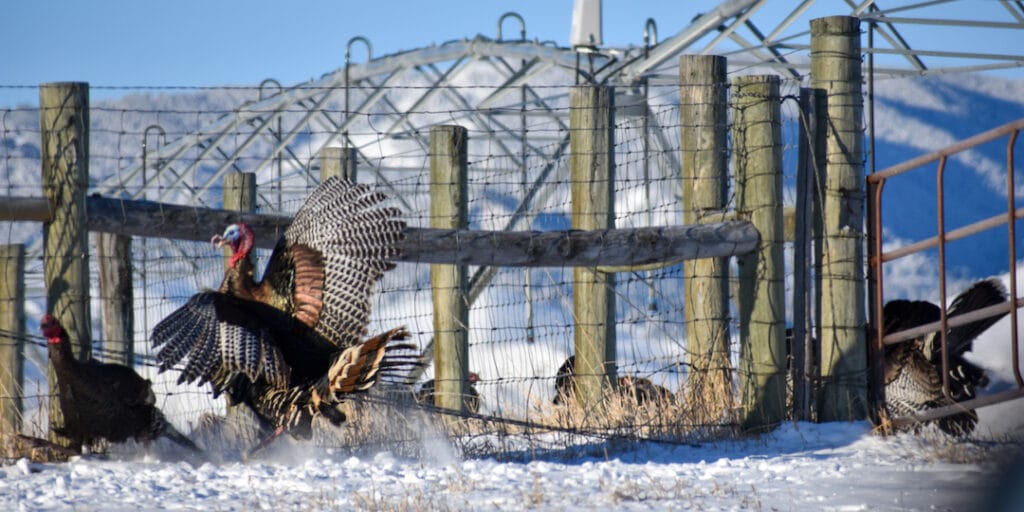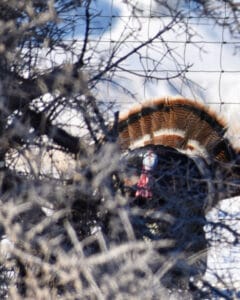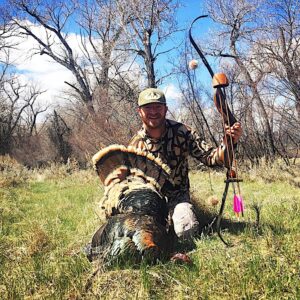I am not what most “die-hards” would call a skilled turkey hunter; some of my tactics would be darn right blasphemous in some circles. That said, I have only been chasing the critter for the last 5 years or so, but I have had plenty of success finding public land birds without any formal training in the matter.
A Little Turkey History
The turkey is not native to Wyoming. The Merriam sub-species were first transplanted in the state in 1935 after trading New Mexico a few of the once-abundant greater-sage-grouse and this newly established population took hold in the state. In turn, this prompted additional relocations in Wyoming throughout the years. The Rio Grande subspecies from Oklahoma made their home here as recently as 1996, and nowadays, wild turkeys can be found in suitable habitats just about everywhere across the state. The populations are doing well.
Due to the gregarious nature of the species and healthy populations, public land users are taking up turkey hunting more now than ever. However, Wyoming is a late bloomer in turkey hunting culture compared to the generations of turkey hunters in other parts of the US, and this is where I come in.
I am relatively new to the sport and have no family heritage around the species. My family has been chasing big game in the Wyoming wilderness for generations and I never even considered hunting turkeys until I could not help but stumble onto them during my various outdoor exploits. With no baseline or expected outcome, I took what I knew from chasing elk and mule deer and got after it. Here are a few approaches and tidbits that have worked for me so far.
Support 84+ Years of Advocating For Hunters & Anglers: DONATE TODAY >>
Glassing for Turkeys
After purchasing my first turkey license, the obvious first step was to locate the quarry. I went at it just like I did elk. I glassed as much country as possible. Wyoming’s wide-open spaces allowed this to work much better than most “traditional” turkey hunters might guess.
I was also surprised where I found the birds; they seemed to be anywhere from riparian corridors, to upland semi-arid habitats, to mountainous areas. They are truly a great generalist just like our beloved wapiti.
With that in mind, don’t be afraid to cover as much country as possible with good optics in tow. And once you locate a group you can be sure they will be hanging around the same piece of country from year to year.

Elk-Calling Turkey Tactics
Also, just like elk, they can betray themselves with audible calls from quite some distance, so getting on a high spot during the early morning calm for a listen is worthwhile. A judicious turkey call can also be used to locate during these times of relative silence. A frustrated tom or nervous hen will usually return in jest, regardless of how genuine your attempt.
This brings me to a point that is probably the most debated, technical, and practiced skill in the sport. Calling turkeys has all the reward, frustration, and myth of bugling elk in September. In all fairness, I am average at best when it comes to calling elk and even poorer at communing with gobblers (especially the untrusting hens), yet I still have enough success to keep me coming back.
Don’t overcomplicate things. Learn as you go. Acknowledging my very limited calling skill set, I rarely call much unless I have plenty of birds and time for trial and error. Also, I have found that much like elk hunting, in those areas that have elevated hunting pressure, the turkeys have heard it all from other hunters. Just shutting up can be the best bet to get in close.
This is not to discredit the art of calling at all. Calling to turkeys can make or break a hunt and there are some true masters out there. However, it is not always necessary to be a master caller to have fun and put a bird in the freezer.
There is endless information on the subject and it is worth studying and practicing. Like anything in our modern world, Google it and/or find a mentor to lessen the learning curve.
How to Get Close

Getting close to a gobbler may depend on your weapon whether, it be archery equipment, shotgun, or rifle (as always, know your state’s hunting regulations). The two biggest approaches I employ are the exact same as I use when getting within bow range of that bull of a lifetime or centerfire distances for high country mule deer. As with most things, there is not a one-size-fits-all approach.
A turkey’s number one strength is its incredible eyesight.
Avian species see in vivid color, unlike our big game, so camouflage and having a disrupted silhouette, I would argue, is more relative than with that close-quarter September bull elk hunt. Match color and shading and use whatever ground cover and topography you can to close the distance. The species can also pick up movement incredibly well. Move slowly and deliberately.
Ironically, this strength of the turkey can also be the chink in its armor.
This acute sensitivity to movement can overload their senses by the presence of wind or even a slight breeze rustling through the vegetation. I have found that I can get away with very little cover when closing the distance on those blustery and snowy/rainy stalks. This sensory overload can make a chess move in the wide-open very plausible.
Ambushing Turkeys
Lastly is the tried and true ambush method, which is fairly self-explanatory. Get in their way and wait them out or call them to your location if you have the patience and skill set to do so. It is a real kick in the tail feathers to fool a big tom in this manner. Find a field, river bottom, or meadow they are frequenting and stay seated at the prime moving times for the most effective turkey ambush. To find where turkeys are frequenting, refer back to the glassing technique I mentioned earlier.
As an added bonus for turkey hunting in Wyoming, most folks are at home nice and cozy during these times, so if it’s not a common turkey hunting destination, the place will most likely be all yours.
To wrap up the long and short of turkey hunting Wyoming, don’t be afraid to put to practice what you already know or just try, try again until your instincts are honed. This newfound sport has pushed my patience and skill set to the limits as much as any monster backcountry hunt and is equally rewarding.
Don’t forget that contrary to what TV shows us, there are no set rules to getting a bird down you must follow (other than the hunting regulations, of course). You might be judged in some circles for not following proper turkey hunting techniques, but not in mine.
Good luck out there, folks. Go enjoy a true Wyoming conservation success story.
PLEASE NOTE: If you’re heading out chasing turkeys, be sure to follow all land use and quarantine measures related to COVID-19 required and/or recommended for your area.

Chris Sheets is a wildlife biologist for the Bureau of Land Management (BLM). He lives in Buffalo, Wyoming where he takes advantage of a ton of big game hunting opportunities, oftentimes while toting his stick bow.
